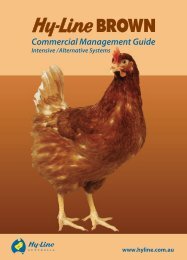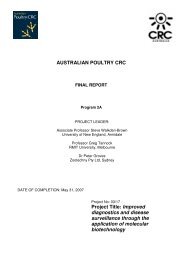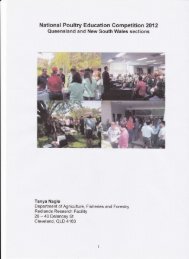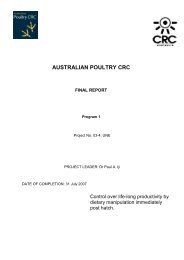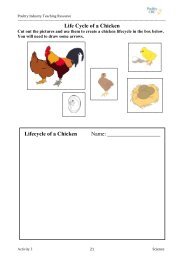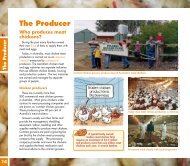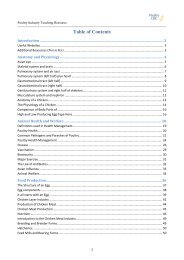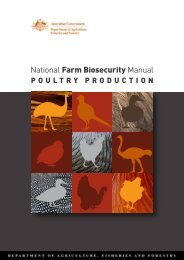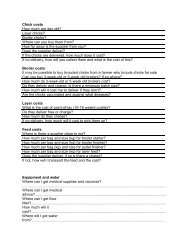AUSTRALIAN POULTRY CRC - Poultry Hub
AUSTRALIAN POULTRY CRC - Poultry Hub
AUSTRALIAN POULTRY CRC - Poultry Hub
- No tags were found...
You also want an ePaper? Increase the reach of your titles
YUMPU automatically turns print PDFs into web optimized ePapers that Google loves.
advertised prior to release, follow up letters and an extension were also provided. The survey itselfwas short with easy to understand questions in a consistent and professional format. As stated beforeevery assurance was given that the results would be confidential and that we valued producer input andopinion. Apart from some telephone follow up, which is difficult especially when contact is madethrough producer groups and associations and not with individual producers; it is hard to say how wecould have increased the return rate of the survey.ImplicationsBacterial infections effect birds on the ground more than birds in cages which impacts on their welfareand adds to the production costs in alternative systems. Significant economic losses to producersoccur because egg production drops and mortality increases. Food safety could also be compromised.RecommendationsProvide advice to producers on how to prevent and combat bacterial infections. Bacterialinfections are spread through live birds (droppings, feathers and other discharges), people(hands, clothing and footwear), contaminated equipment, eggs, air, feed and water, animals(dogs, cats, rats and mice) and insects (mosquitoes, flies and beetles). Ways to combatbacterial infections include biosecurity, medication, separation of birds that are infected, andbirds of different ages, alleviation of stress (malnutrition, overcrowding and dirty conditions),vermin control and clean waterers and feeders.One problem is that there are virtually no medications for use against opportunistic infectionscausing reproduction tract problems. The only option is to improve hygienic conditions andincrease the level of biosecurity in the sheds and on the farm in general. Following avaccination program and preventing outbreaks of other bacterial diseases (such as fowl choleraand coryza) will help to decrease reproductive tract complications and improve eggproduction. Round worms are a potential vector for bacterial disease with piperazine the onlyanthelmintic available for hens in lay, and this should be addressed. As well there are limitedoptions for external parasite control all of which increase disease potential.An investigation into microbial population of the oviduct in free range, barn and cage systemcould uncover potential for the identification of microflora that could be used as a futureprobiotic.With producers diagnosing 80 – 100% of „cause of mortality‟ on-farm, the possibility ofmisdiagnosis is increased especially if symptoms are similar (e.g. fowl cholera and spottyliver). Increased producer education and improved use and availability of professionals mayresult in an early and correct diagnosis of „cause of mortality‟ therefore decreasing the impacton the birds and production.AcknowledgmentsThe authors would like to thank Karen Norris, Dr John Barnett, Mrs Ivy Inwood, Dr Pat Blackall, DrNigel Perkins and Avril Finn for their advice and help with the survey; the QDPI&F BiosecuritySciences Laboratory; the participates who responded to the nationwide survey and particularly the fivefree range producers in South East Queensland who let us undertake the epidemiological survey ontheir properties.30



